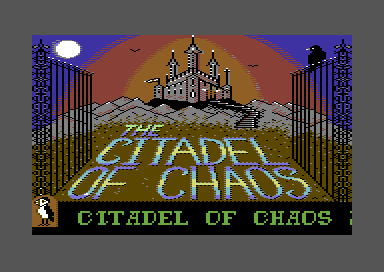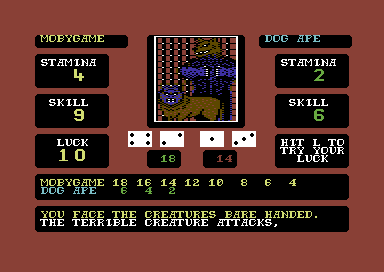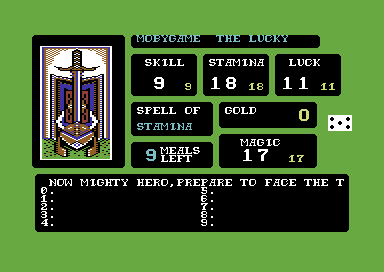Retro Replay Review
Gameplay
The Citadel of Chaos delivers a classic choose-your-own-adventure experience by translating Steve Jackson’s Fighting Fantasy gamebook into a fully interactive digital format. As you wander the grim corridors of Craggen Rock, you make critical decisions from multiple-choice menus that shape your path forward. This structure retains the charm of flipping through pages, but adds streamlining by automating die rolls for combat tests and skill checks. The result is a seamless blend of old-school narrative exploration and modern convenience.
Combat encounters strike a careful balance between strategy and chance. Your character’s stats—Skill, Stamina, and Luck—are generated and tracked for you, eliminating the need for physical dice. Each skirmish against goblins, warlocks’ apprentices, or summoned beasts becomes an exercise in tactical decision-making: decide when to strike, parry, or flee. The inclusion of spells and potions further deepens the choices, demanding you weigh risk versus reward at every turn.
Inventory management is simple yet engaging. You juggle the essentials—your blade, spellbook, healing potions, and a handful of miscellaneous items—while constantly scanning narrative text for clues on when to cast spells or use special items. Although the limited carrying capacity can feel restrictive, it encourages thoughtful planning and adds a layer of suspense: will you save that last vial of green healing elixir for the next tough battle, or use it immediately and risk running out later?
Exploration in the Citadel is non-linear, with secret passages and hidden rooms peppered throughout the labyrinth. Backtracking can feel repetitive at times, but each revisit holds the promise of unlocking shortcuts or discovering new narrative branches. Even if you fall in combat, the game’s checkpoint system returns you to the last decision point, avoiding punishing restarts and inviting you to experiment with different approaches.
Graphics
Visually, The Citadel of Chaos embraces a retro aesthetic that pays homage to early ’90s adventure games. Each multiple-choice prompt is accompanied by a small, hand-drawn illustration that evokes the gritty, torchlit atmosphere of Craggen Rock. While not pushing the limits of modern hardware, these images capture the foreboding mood and give players a clear sense of what lurks around each corner.
The scrolling narrative text window is clean and readable, with subtle decorative borders reminiscent of leather-bound pages. This presentation feels authentic to the source book while maintaining user-friendly typography. Background details—stone walls, iron-bound doors, flickering torches—are functional rather than flashy, ensuring that the story always remains front and center.
During combat, the screen shifts to a simplified battle interface showing your current stats alongside a small portrait of your opponent. Though these portraits are static and minimalist, they effectively convey the variety of creatures you’ll face, from snarling goblins to the eerie countenance of Balthus Dire’s lieutenants. Animations are minimal, but the judicious use of sound effects—metal on metal, distant howls, arcane crackles—enhances immersion.
Overall, the graphics reinforce the game’s heavy emphasis on narrative and decision-making, rather than spectacle. If you go in expecting high-definition 3D models or dynamic camera angles, you may feel underwhelmed. But for fans of text-driven adventures, the artwork and interface strike a nostalgic and functional chord.
Story
The narrative thrust of The Citadel of Chaos is straightforward but compelling: infiltrate the Black Tower’s stronghold, outwit its denizens, and face off against the warlock Balthus Dire to save the Vale of the Willow. What sets it apart is the branching structure lifted directly from the original Fighting Fantasy gamebook. Each choice you make—whether to sneak past an orc patrol, challenge a sorcerous acolyte, or explore a shadowy side passage—unfolds unique narrative text that can lead to triumph or sudden peril.
Steve Jackson’s dialogue and descriptive passages are faithfully adapted, preserving the witty flavor and tense atmosphere of the source material. The pacing is excellent; cliffhangers and plot twists appear regularly, compelling you to read on or replay sections to find alternative routes. Occasional humor peeks through in the narrator’s aside comments, lightening the mood between bouts of dark magic and monstrous foes.
Despite its linear overarching goal, the story offers surprising replay value. Different playthroughs reveal new rooms, unexpected NPC interactions, and secret treasures hidden behind obscure clues in the text. Encountering an event you missed previously—whether a magical fountain or a cryptic riddle—provides genuine excitement and encourages multiple runs to uncover every thread of the narrative web.
Though the storyline itself remains simple—a lone hero versus a malevolent warlock—the depth comes from player choice. Every failed escape or narrow victory feels significant, as the text reminds you of the Vale’s fate and the stakes of failure. It’s a testament to the design that a game rooted in page-turning paragraphs can sustain engagement over repeated ventures into the castle’s depths.
Overall Experience
The Citadel of Chaos offers a focused adventure that will particularly appeal to fans of classic gamebooks, text adventures, and turn-based RPGs. It presents a tidy package: clear mechanics, faithful adaptation of source material, and a hauntingly atmospheric setting. While it doesn’t compete with large-scale modern RPGs on graphical or open-world depth, it delivers a satisfying dose of challenging decision-making and narrative exploration.
For newcomers, the automated dice rolls and character tracking remove barriers that traditional pen-and-paper gamebook readers might face, making the genre more accessible. Veterans of Fighting Fantasy will appreciate the authenticity and the attention to detail in each choice point. And the moderate length—around six to eight hours for a thorough first playthrough—strikes a nice balance between brevity and content density.
Replayability is one of the game’s strongest suits. With multiple endings, hidden paths, and optional encounters, it invites you to return to the Black Tower armed with new strategies and a thirst for secrets. Even if you’ve already conquered Balthus Dire once, alternative routes can lead to fresh surprises and narrative hooks.
In summary, The Citadel of Chaos stands as a polished, engaging title for anyone intrigued by narrative-driven gameplay. Its faithfulness to Steve Jackson’s original vision, combined with user-friendly digital enhancements, makes it a standout adaptation—a must-try for old-school adventurers and curious newcomers alike.
 Retro Replay Retro Replay gaming reviews, news, emulation, geek stuff and more!
Retro Replay Retro Replay gaming reviews, news, emulation, geek stuff and more!








Reviews
There are no reviews yet.